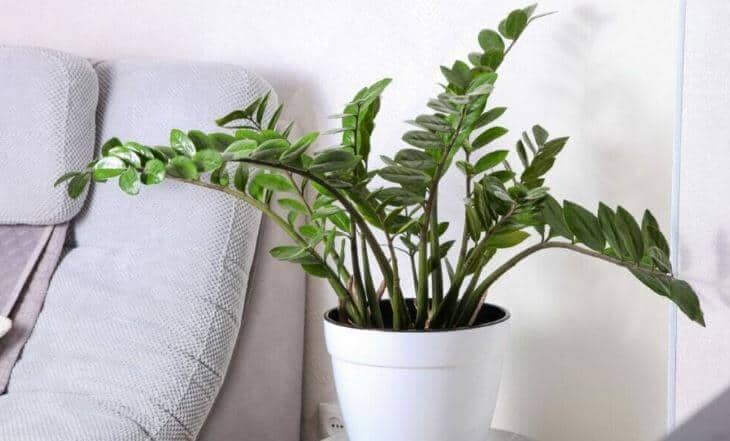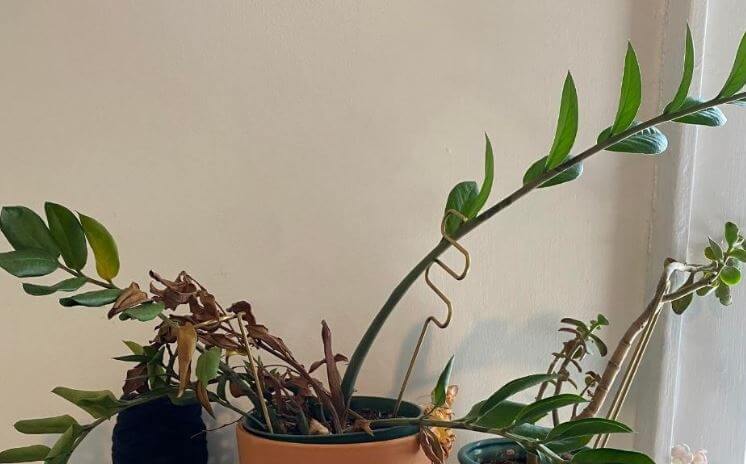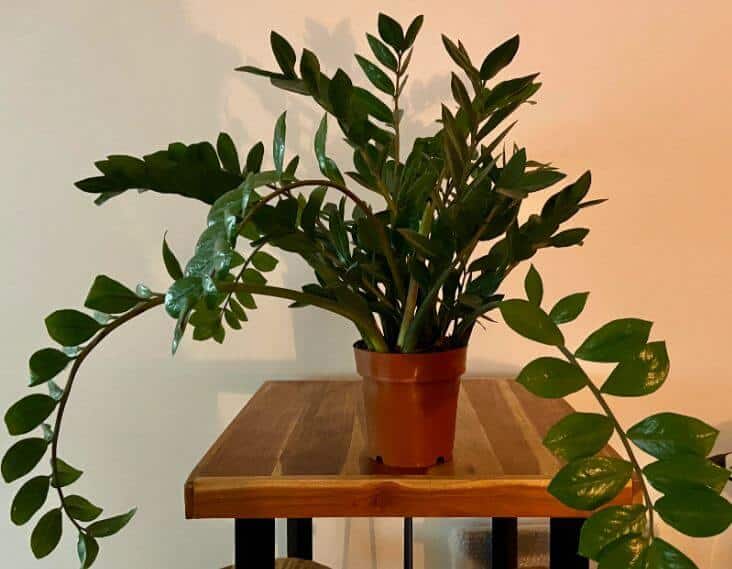Last Updated on May 9, 2023 by a Friendly Gardener
ZZ plants are great houseplants because they require so little commitment from indoor gardeners and will thrive even when a bit neglected. So, when a ZZ plant becomes droopy, it is a bit of a cause for alarm. Why is my ZZ plant drooping? Is it going to die? The challenge will be in determining what it is that is causing your plant to droop.
Also popularly known as the Zanzibar Gem, the Zamioculcas Zamiifoglia is a unique African tropical plant that boasts glossy deep green-hued foliage on stems growing upward. These plants are favorites for beginner gardeners and those with limited time to dedicate to houseplants because they require only minimal care.
Belonging to the Araceae family, they depend on thick rhizomes situated underground that store the plant’s water. This particular characteristic contributes to their resistance to drought and why they handle the occasional watering forgetfulness without a problem.
Common Causes of a Drooping ZZ Plant

Improper Lighting
While ZZ plants can adapt to most environmental lighting conditions, they will thrive the most when recipients of very bright, indirect lighting, or a spot with partial shade. If a ZZ plant does not receive sufficient light exposure, it will begin to produce smaller foliage, appear leggy, and may become droopy.
If it experiences excessive sunlight exposure leaves can scorch. They will turn brown and begin to fall off stems. Your ZZ needs a generous amount of bright light that is rigorously indirect. The ideal time for daily sun exposure is in the morning when sunlight is less harsh.
Overwatering

This may be the most common reason for a droopy ZZ plant. Excessive water will debilitate your plant through soggy soil that inhibits proper aeration of the root system. Waterlogged soil leads to the development of root rot and weakens your plant making it more susceptible to infections and diseases.
The ZZ plant’s root system features rhizomes. These growths resemble tubers or potatoes and are tasked with storing water for drought periods ensuring the plant’s survival. ZZ plants require watering only when the soil bed dries out completely. Apart from a droopy plant, other symptoms of overwatering include the ZZ plant stems drooping, yellowing foliage, and mushy stems featuring brown lesions.
In the event of overwatering, your plant should be removed from soggy soil and repotted in fresh soil.
Root rot is generally caused by overwatering, or poor drainage leading to soggy soil. Soggy soil conditions essentially drown your plant’s roots by inhibiting the flow of oxygen to the plant’s root system. If the soil feels damp and the plant is wilting, examine the root system. If roots are brown and mushy and there is a foul smell. Your plant has a case of root rot. If root rot is developing, remove infected roots and repot.
Soil quality is also a consideration when overwatering occurs. A well-draining soil mix and proper container drainage are essential to ensuring root system aeration. The soil must have enough moisture retention for rhizomes to store water yet still drain away excess moisture. Blend two parts of quality potting soil with one part perlite and one part sand to guarantee drainage.
Underwatering
Although ZZ plants tolerate drought conditions, they still need water to survive. Insufficient watering can be just as problematic as excessive moisture. This is particularly so during the summer months. When ZZ plant stems begin to appear shriveled and begin drooping, your plant most likely needs water. Brown crispy leaf tips or shriveling foliage that eventually drops also is symptomatic of too little water. Check the soil bed as well as the soil near the container’s drainage holes.
Remember to water your ZZ plant when the soil bed feels completely dry. This may be once or twice monthly depending on the indoor climate.
Inadequate Nutrition

Just like us, plants need nourishment. Water and sunlight are just two of the vital components that ensure plant survival. ZZ plants also need nutrients found in their soil beds. Feeding a Z plant with a bit of fertilizer can also contribute to your plant’s health. If the soil bed has exhausted its supply of nutrients, your ZZ plant may begin to droop, and foliage may begin to yellow.
The Zanzibar Gem does not require much feeding. To ensure an adequate nutrient supply, fertilize your plant once or twice during its growing season. More fertilization than this can contribute to salt buildup in the soil which will harm the plant’s root system. Burns or yellow spots on foliage indicate overfertilization. Use a mild balanced fertilizer that has been diluted to prevent salt buildup.
Improper Environmental Temperatures

ZZ plants need warm temperatures that measure between 65à and 85°F. If your plant is exposed to temps that fall below 45/50°F, wilting may occur, and leaves may begin to yellow and shrivel. Drafty locations, especially cold drafts can exacerbate these symptoms, so keep your plant away from potential sources of drafts like doors, windows, and hallways.
Improper Humidity
The ZZ plant likes humidity levels that measure between 40% and 50%. If humidity is too high, this condition can contribute to overwatering and the development of root rot, both causes of a droopy ZZ plant. It is inadvisable to place a ZZ plant in rooms that have higher humidity such as bathrooms or kitchens. Also, avoid misting this plant as it does not need it.
Your ZZ Plant Is Rootbound

ZZ plants have a slow growth rate hence they rarely need to be repotted more than once every two to three years. When a ZZ plant becomes rootbound, it may start to droop because it struggles to absorb sufficient water and nutrients. Your plant will need a larger container. When roots peek through drainage holes, your plant probably needs more space. If you need to repot, do so in the spring or summer during the growing season.
Pests
ZZ plants are not overly susceptible to pest infestations. When pests do infiltrate, they are usually pests that attack root systems such as fungus gnats. An occasional mealybug may appear on stems or foliage.
To contrast a fungus gnat infestation, use sticky traps. Also, replace the top two inches of soil to remove any eggs that have been deposited. Wait to water, as fungus gnats are attracted to root rot and fungal infections. For mealybugs or other common houseplant pests, apply insecticidal soap or use neem oil.
Can a Droopy ZZ Plant Recover?
Absolutely yes, if the proper environmental and cultivation conditions are provided.

